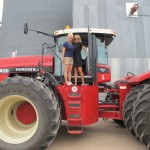 Recently, CommonGround Colorado volunteer Danell Kalcevic, who farms and raises cattle outside of Denver, penned an op-ed on why consumers may see higher beef prices this grilling season. While some may say farmers and ranchers must be profiting from this rise, Kalcevic explains how last year’s drought is still impacting ranchers.
Recently, CommonGround Colorado volunteer Danell Kalcevic, who farms and raises cattle outside of Denver, penned an op-ed on why consumers may see higher beef prices this grilling season. While some may say farmers and ranchers must be profiting from this rise, Kalcevic explains how last year’s drought is still impacting ranchers.
May Snow Showers Bring Spring Crops for Farmers
As we gear up for grilling season, many shoppers may notice higher beef prices at the grocery store. Beef prices are triggered by supply and demand, and this year, the supply is low. “How low?” you ask. The last time cattle numbers in the U.S. were this low was it was 1952.
Moisture—or the lack thereof—is the culprit for supply issues in the beef industry. I know it might seem like it’s been snowing and raining nearly every day the last couple of weeks, but the lack of moisture in our region over the past ten years has caused strain on the feed supply, and ultimately our cattle supply. For cattle farmers like me, the price of beef depends on the commodity prices for wheat, corn and soybeans—all of the big commodities used in feeding cattle.
A low supply and high demand normally means the person selling the goods in demand will make a large profit. This theory does not hold true in agriculture. In reality, it costs more to produce our low supply of cattle, and we are by no means getting rich off of the profits. Farmers actually see less than 12 cents for every dollar spent on food in America. The rest of the money goes to processing, transportation and marketing.
Call us crazy, but my family considers the recent snowy weather a blessing. Sure blizzard conditions make getting in the field or feeding cattle difficult, but with this type of moisture farmers will be able to plant a much greater supply of crops like corn or soybeans. And we are hopeful that being able to plant more spring crops will help bring those cattle numbers back up and your beef prices down!
Sincerely,
Danell Kalcevic, farmer, Bennett, Colo.
